The Ultimate Guide to Grounding: You can easily transform your space for meditation. Just add the right low seating. Find the 10 best Floor Cushions here. They blend simple design, natural textures, and perfect support for your Zen room.
Introduction: Why Choose Floor Cushions for Zen
Welcome to the world of calm design. Here, every item helps bring peace. Floor Cushions are not just for looks; they are vital to a Zen space. Big chairs feel too much for a quiet room. Floor Cushions give you the perfect low seat. They help you feel grounded and still.
The best Floor Cushions for a Zen room use simple shapes and natural materials. They give great support for sitting a long time. We picked 10 styles that look good and feel calm. This guide ensures your sanctuary is both peaceful and stylish.
The Best Floor Cushions for Your Tranquil Zen Room
To make a calm space, you need special, low seating. These Floor Cushions focus on simple design, natural textures, and comfort.
Traditional Zafu Meditation Floor Cushions
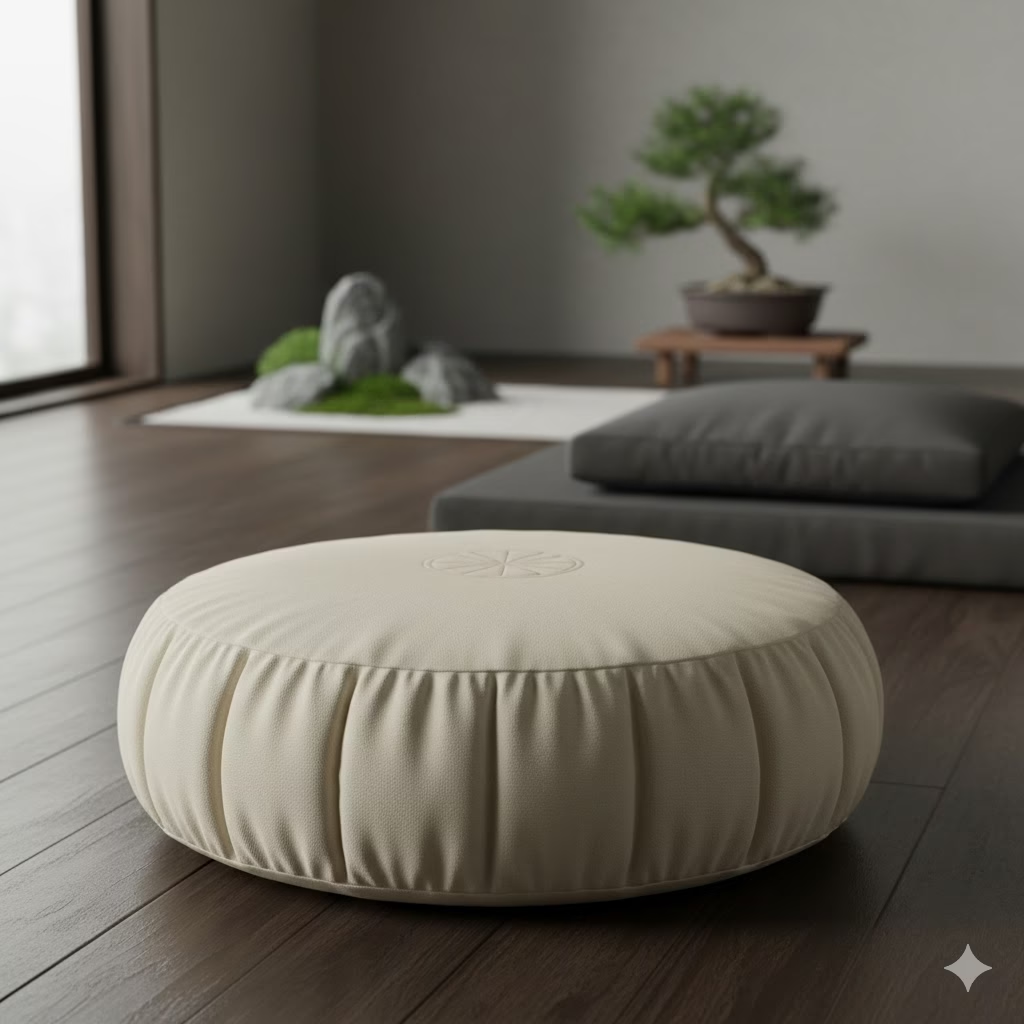
The Zafu is the most important Zen seat. It is a main item among Zen Floor Cushions. Having been built for comfort during deep meditation. It is much more than a simple cushion.
Design and Dimensions
You know a Zafu by its round shape and neat side pleats. It stays tall because of these pleats. Zafus are usually 12 to 16 inches wide and 4 to 6 inches tall. This height is important. It lifts your hips up and keeps your spine straight. This stops back pain and helps you sit up easily for a long time.
Materials and Support
The cover uses a strong, natural fabric. Think durable, unbleached cotton canvas or hemp. These materials last a long time. They also have a plain look that fits the Zen style.
The filling gives the Zafu its best support:
- Kapok Fiber: The classic fill. This soft, natural fiber is packed tight. It makes a firm, light center.
- Buckwheat Hulls: The most popular fill today. These hulls are firm but mold to your shape. They give stable support. This helps you feel grounded.
Ideal Use and Aesthetic
These Floor Cushions are needed for mindful practice. Their simple shape and neutral colors (cream, sage, charcoal) show the Zen ideals of order and peace. The Zafu helps you focus. It is a stable base for your body.
Zabuton Square Floor Cushions

The Zabuton Mat finishes the main seat. It sits under the Zafu. These thick, flat Floor Cushions are key. They cushion your legs and feet against the hard floor. This helps you sit longer without pain.
Dimensions and Construction
The Zabuton is a large, flat, square or long mat. It is often over 30 inches wide. This size gives enough space to support your lower legs. This keeps your joints comfortable.
The mat uses thick, padded cotton or linen fabric. These fibers last well. They also keep the cold floor away. The inside has foam or cotton layers. This makes a stable base that will not go flat easily.
Ideal Role in a Zen Room
The Zabuton does more than feel soft. It helps mark the sacred space for practice. You should pick solid, muted colors. Use earthy shades like stone grey or cream. This ensures the cushion does not draw attention. It helps you focus inward.
Japanese Shikibuton-Style Floor Cushions

The Shikibuton cushion is very useful for low-profile living. These flat, useful Floor Cushions are like Japanese bedding. They work well for the many needs of a modern Zen room.
Form and Functionality
These Floor Cushions are thicker and larger than typical mats. They give great comfort without being bulky. They save space. You can easily fold or roll them for quick storage. This lets you change your room fast.
They have many uses:
- Large Meditation Mat: Provides a soft area for yoga or group practice.
- Floor Lounger for Reading: Put it by a wall. It is a comfy spot for long, quiet reading.
- Temporary Bedding: Stack or lay these Floor Cushions flat. They make a good bed for guests.
Aesthetic and Materials
The Shikibuton look fits the simple Japanese style. Its simple, clean lines come from using natural fibers. The covers are made from smooth cotton or linen. This fabric feels cool and breathable. They use neutral tones (white, light grey). This keeps the cushion a quiet item.
Low-Profile Woven Jute/Seagrass Cushions
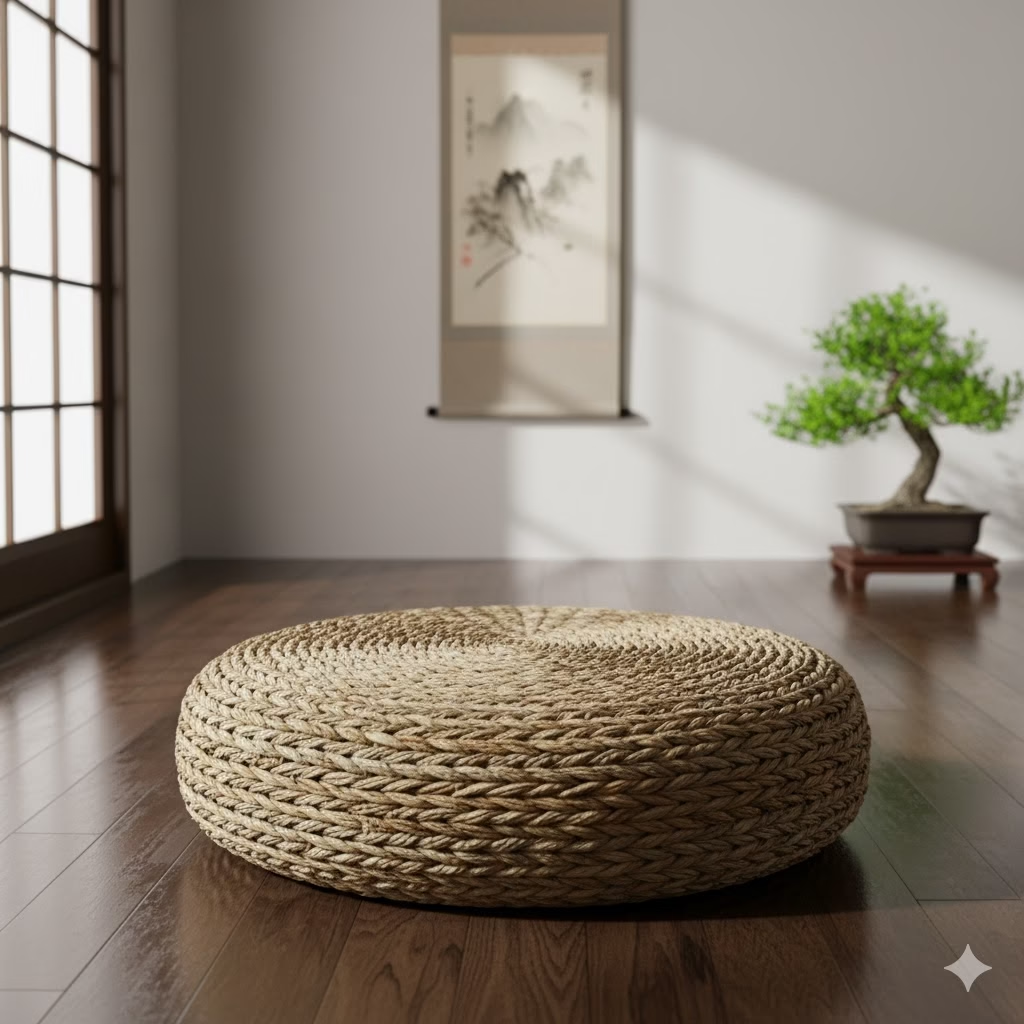
These natural fiber Floor Cushions are a main feature in Zen design. They add a great earthy texture. And use no bright colors or fake materials. They give you a sturdy base that feels connected to nature.
Material and Texture
These special Floor Cushions use only natural fibers. They are woven from raw jute or seagrass. This is a green choice.
The texture is rough and natural. It helps the room feel grounded right away. These woven Floor Cushions are firm. This firmness gives a nice balance to softer fabrics.
Ideal Use and Aesthetic Integration
These woven pieces are very low-profile. They fit quietly into a Zen room.
- Aesthetic Pairing: The natural color (light tan or muted beige) looks great. It pairs well with natural wood. This keeps the Zen room clean and simple.
- Grounding Layer: They are great as a base for smaller cushions. Put a Zafu on top. This makes a clean, stable area for your practice.
- Functional Accent: They are firm. This makes them perfect as a footrest or a simple side table for a teacup.
Felted Wool Meditation Bowls

Felted wool is a nice, quiet choice for seating. The wool bowl is a unique option among Zen Floor Cushions. This soft material looks very natural and gives soft support.
Material and Craftsmanship
This Floor Cushion is made from dense, compacted felted wool. This method makes a thick, firm material that is tough. Wool keeps you warm. It resists dirt and stains naturally. Also, the solid felt is completely silent. This means no noise will break your focus.
Shape and Aesthetic
These special Floor Cushions are shaped like a slight bowl or nest. This soft shape gently holds your body. It helps you settle into the moment. The wool’s soft look and organic shape fit well in a Nordic or Wabi-Sabi Zen room. They add quiet warmth.
Simple Linen Floor Pillows
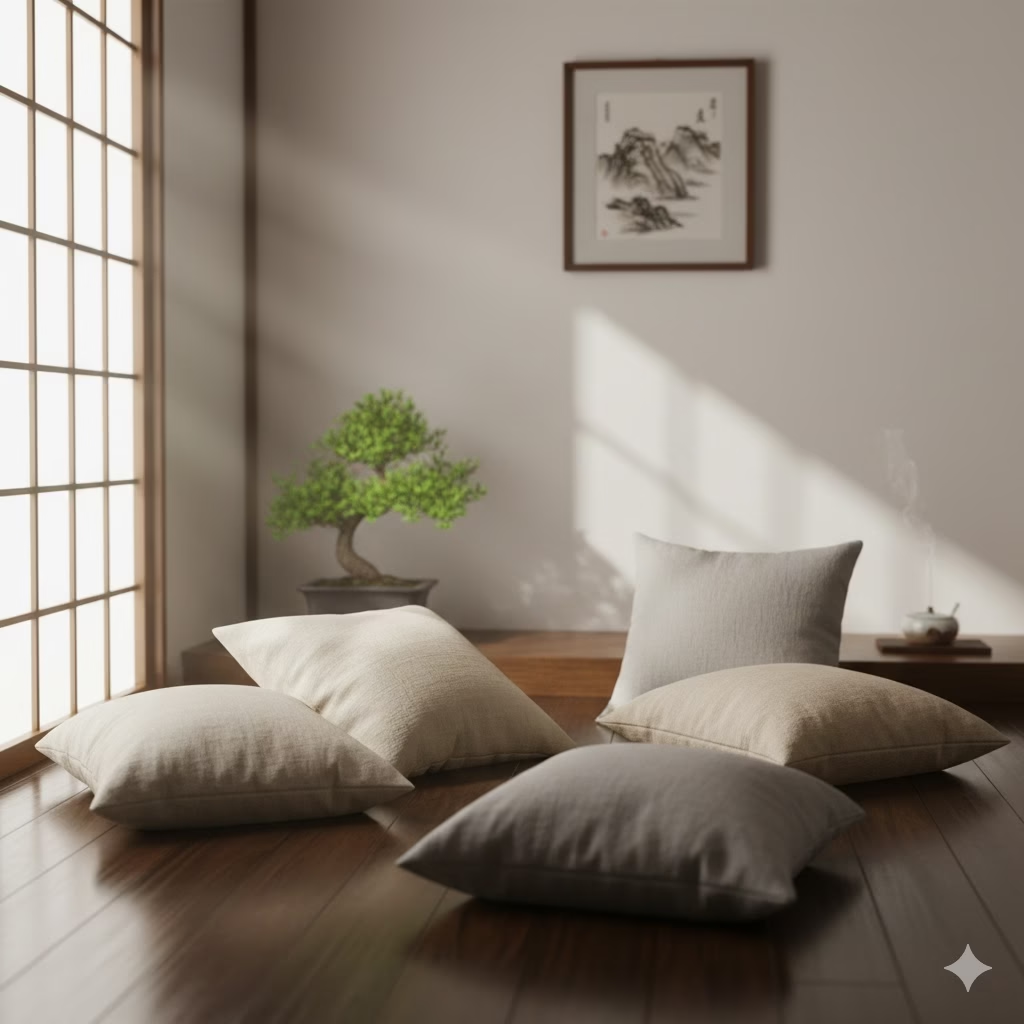
Linen is soft but still looks clean and natural. Simple linen pillows are ideal Floor Cushions for easy rest in a Zen room. Linen looks casual yet elegant.
Material and Texture
These Floor Cushions are made from washed linen or flax fiber blends. Linen breathes well. It is durable. It feels cool and comfy.
Linen wrinkles easily. This is a good thing in a mindful space! These natural creases give a soft, lived-in texture. This relaxed look fits the Zen love for realness.
Shapes and Ideal Use
These Floor Cushions are often large, square, or rectangular. They cover a wide area.
- Ideal Use: They are too soft for main meditation. They work better as a backrest against a wall. And are great for quiet lounging after practice. They help your body release tension.
Modular Floor Mat Seating

Some Zen spaces are for more than one person. Think tea rooms or study areas. Modular Floor Mat Seating is very flexible. It works better than single Floor Cushions. This style is perfect for changing your space quickly.
Functionality and Adaptability
These units are built to move. They are single Floor Cushions that you can link or move around. You can make the seating bigger when friends visit. Or, you can stack them away neatly. This keeps your room clear. Tidy storage is key in Zen design.
Aesthetic and Order
Modular seating has clean, straight lines. This helps keep the room ordered and calm. These Floor Cushions use only solid colors. Choose quiet shades like light grey or off-white. This look keeps the room uncluttered, even when you move the seats.
Neutral Chunky Cotton Knit Cushions
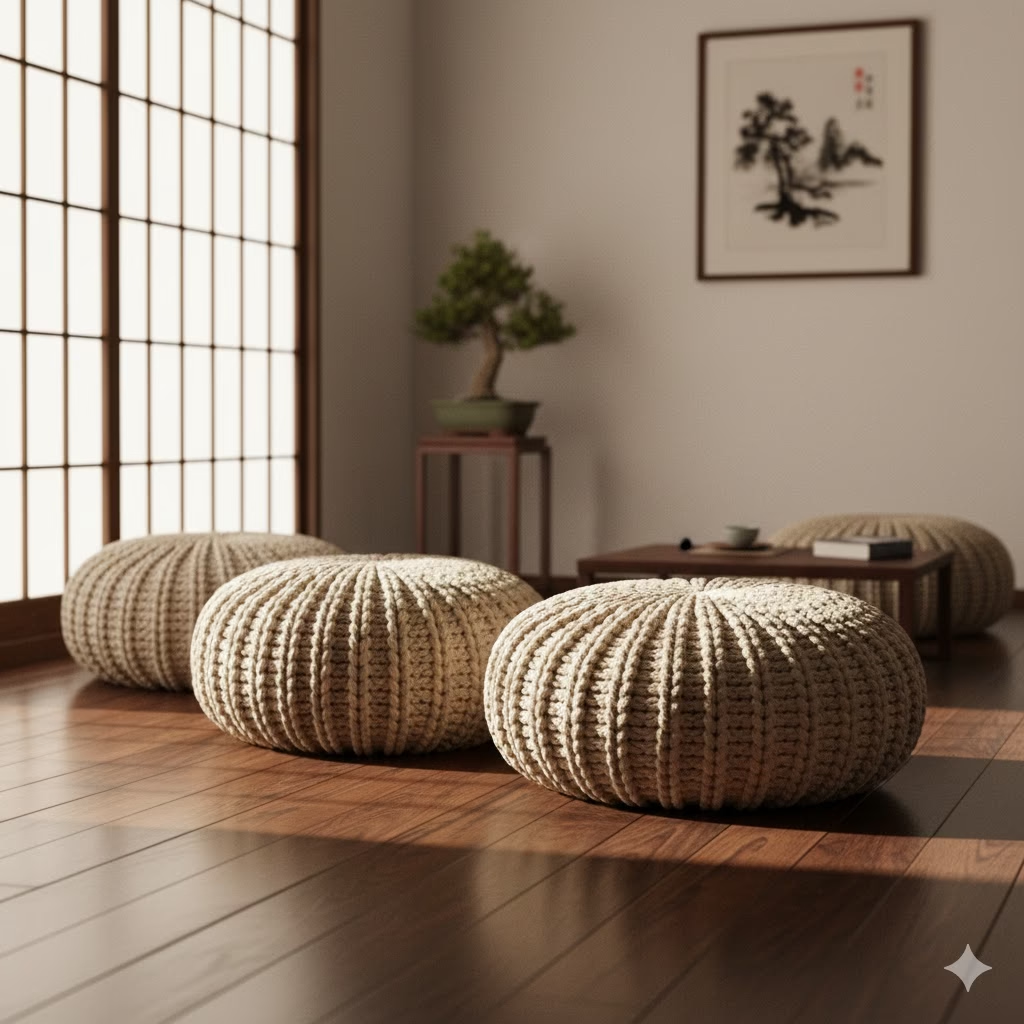
Chunky cotton knit feels cozy and breathable. It is a warm texture that fits a cozy Zen room. These Floor Cushions are great for feeling peaceful and very comfortable.
Material and Sensory Appeal
They are made from soft, thick cotton cord or yarn. Cotton feels gentle. It is breathable all year. The large knit adds texture. It makes you want to sit and relax.
Colors and Ideal Use
To fit the quiet room, the colors must be neutrals. Use shades like cream, eggshell, or light stone. These calm colors let the texture be the star.
They add a feeling of Hygge (coziness). And for relaxing. They are perfect near a bookshelf. They make the space great for quiet reading or writing. These soft Floor Cushions warm up a simple room.
Hand-Stitched Boro-Style Poufs
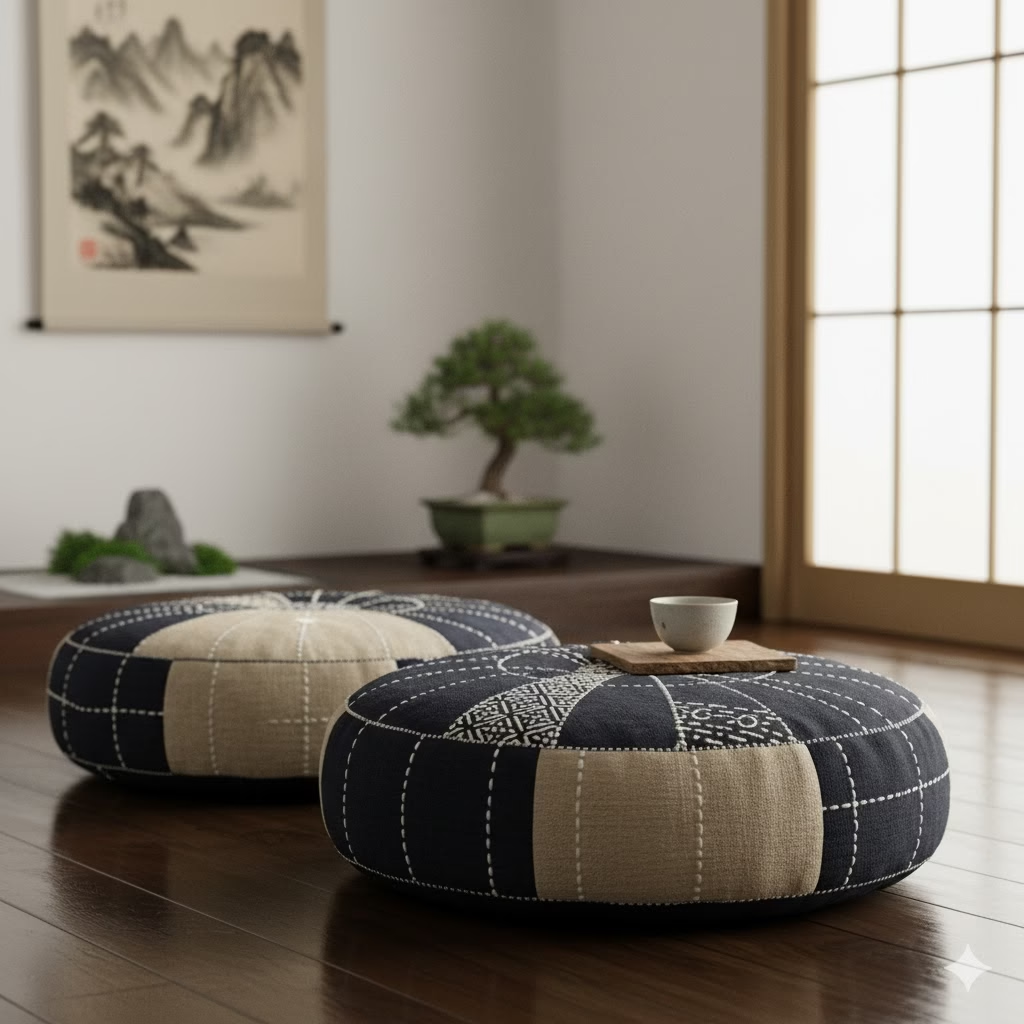
The Boro-Style Pouf feels very historic and authentic. It is a powerful texture among Zen Floor Cushions. It uses the Japanese Boro tradition. This style loves saving fabric and finding beauty in mending. This fits the Zen love for imperfection.
Details of Craftsmanship
These Floor Cushions are unique. They are made by joining fabric scraps with visible hand-stitching (Sashiko). They use strong, natural fabrics like indigo-dyed cotton or hemp. This dense stitching makes them last. It also creates a subtle pattern of neat lines.
Aesthetic and Function
The Boro look adds a handmade feel without bright colors. The colors (deep indigo, charcoal) are very calming.
These Floor Cushions are densely filled and firm. They work well as a low stool, a stable base for a small lamp, or a handy side table for small items. They honor mindful craftsmanship.
Round Tatami Rush Grass Mats
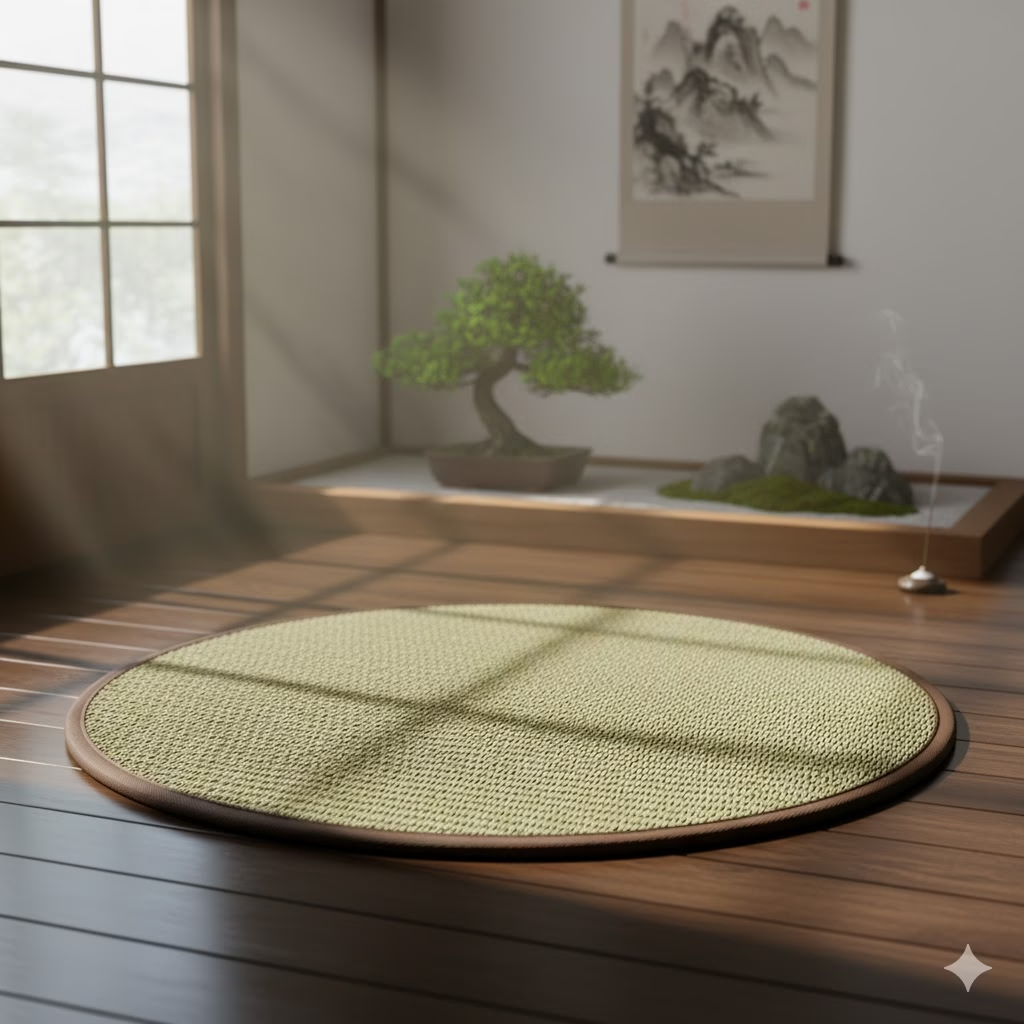
The Round Tatami Rush Grass Mat is not a pillow. It is a vital item that works perfectly with your Floor Cushions. These mats give the right base for a traditional Zen space.
Material and Sensory Details
The mat is made from woven rush grass. It has binding, like classic tatami. The fresh grass gives off a gentle, naturally fragrant smell. This small scent helps with calm. The mat is firm. It gives a stable surface for your softer Floor Cushions.
Purpose and Aesthetic
These round mats have two uses. First, they protect your soft Floor Cushions. Second, the round shape helps mark a seating area on the floor. Their crisp, golden-green texture is very calming. This simple, organic item fits a traditional Japanese-style Zen room.
Key Considerations Before Buying Floor Cushions
The materials you choose should help you find peace.
Choosing the Right Filling and Firmness
The filling is very important for comfort.
- Buckwheat Hulls and Kapok: Best for main meditation Floor Cushions. They hold their shape for firm spine support.
- Cotton/Linen Batting: Best for Zabutons and pillows. They give soft cushion for legs or back support.
- Avoid: Do not use soft foam or poly-beads. They don’t offer the firm, natural support you need.
Maintenance and Natural Care
Pick Floor Cushions that are easy to clean without strong soap.
- Natural Fabrics: Look for linen or cotton covers that are removable and machine-washable.
- Spot Cleaning: For covers that don’t come off, use a light, damp cloth and gentle soap for spot cleaning.
- Longevity: Cushions with natural fillings need to be aired out sometimes. This keeps them fresh.
The right Floor Cushions invite you to slow down. They help you connect with your space. By choosing cushions that match the Zen rules, you create a dedicated, peaceful haven. Which style will be the start of your tranquil retreat?
References
- Runtoyoga – ancient origins of the Zafu cushion
- Heddels – the Japanese philosophy of Wabi-Sabi
- Jlifeinternational – The Timeless Appeal of Japanese Living
Recent Posts
Now that your Zen room is complete, find your next culinary inspiration and explore our existing content With some relaxing teas.


